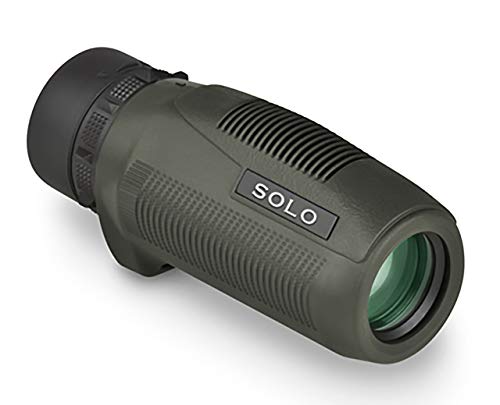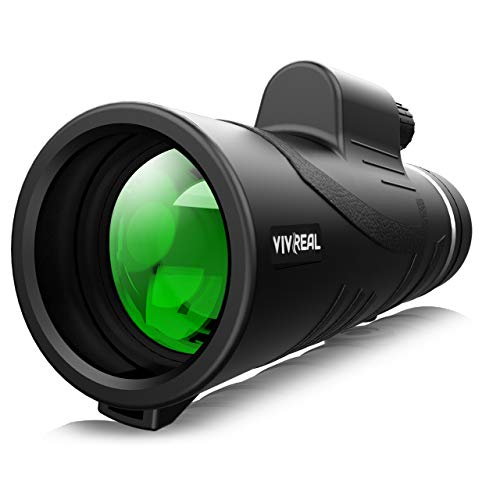10 Best Monoculars of 2025 – Top Picks & Reviews
Last Updated on
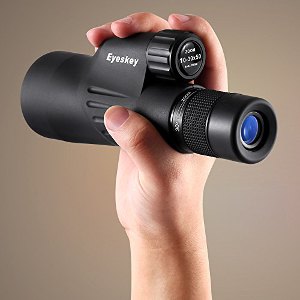
For many, binoculars are the go-to choice when they need to magnify their view and see something far away in great detail. No doubt, binoculars are great for this, but they’re not the only option. Sometimes, they’re just too bulky and big, which is where monoculars reign supreme. These tiny tools are significantly streamlined compared to binoculars, allowing them to easily slide into your pocket and making them perfect for one-handed viewing.
Like binoculars, there are many monoculars to choose from. But today’s monoculars aren’t like the relics from years past. They’ve become small, sleek, and powerful, offering excellent optic quality and a wonderful viewing experience.
But that doesn’t mean that all monoculars are created equal. We’ve tested quite a few of these useful tools in the process of writing the following reviews, and we’ve found that some are clearly superior in their form and function. If you want to ensure that you pick the best monocular, then read on to find out how some of the most popular options compare.

A Quick Glance at our Favorite Monoculars for 2025
| Image | Product | Details | ||
|---|---|---|---|---|
| Best Overall |
 |
Wingspan Optics Explorer Monocular |
|
CHECK PRICE |
| Best Value |
 |
Roxant Grip Scope Monocular |
|
CHECK PRICE |
| Premium Choice |
 |
Bushnell Legend Ultra HD Monocular |
|
CHECK PRICE |
 |
Vortex Optics Solo Monocular |
|
CHECK PRICE | |
 |
VIVREAL Monocular |
|
CHECK PRICE |
The 10 Best Monoculars
1. Wingspan Optics Explorer Monocular – Best Overall
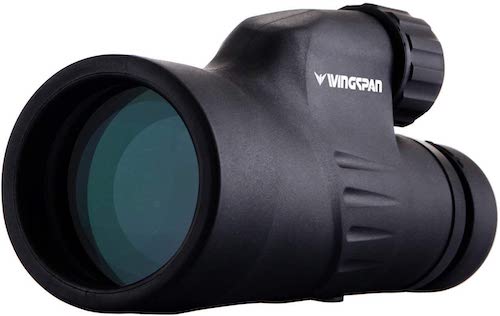
With all of the great monoculars to choose from, it can be difficult to pick just one. But if we have to, we’re going with the Wingspan Optics Explorer. This device is loaded with top-quality features that provide an excellent viewing experience.
With 12x magnification, this monocular will help you see up to 1,000 yards away, while other monoculars we tested were unusable at this distance. To be fair, the image isn’t excellent at 1000 yards, but you get 1,000 yards of visibility. Thanks to the 14-millimeter eye relief, anyone can comfortably use this monocular, even if you’re wearing glasses.
Unfortunately, this is one of the bulkier monoculars we tested, mainly due to the large 50-millimeter objective lens. This allows for a sufficient field of view of 246 feet but makes for a larger package overall. Thankfully, it’s coated in a durable, non-slip rubber armor that will prevent it from slipping out of your hand and offer protection in case it does. For further protection, this device is also waterproof and fog-proof, so you don’t have to worry about it when you’re stuck in inclement weather. Overall this is the best monocular on the market this year.
- Waterproof and fog-proof
- Non-slip armor
- Viewing range up to 1,000 yards
- 12x magnification
- 14mm eye relief works with glasses
- Big and bulky compared to other models
2. Roxant Grip Scope Monoculars – Best Value

You can’t get much cheaper than the Roxant Authentic Grip scope. But does it offer good value for money? With dimensions of 5.5″ x 2″ x 2″ and the weight of 7.8 ounces, this is a fairly compact scope. The fully multi-coated all-glass lens offers good optics, but only offers up to 6x magnification which may not be enough for some people. The exterior of the monocular is described as a no-slip comfort molded grip and it’s fair to say that this is quite accurate. It’s unlikely to slip out of the hand and it’s comfortable to hold.
Despite the low price, this product does have some special features. It has a retractable eyecup which makes it much easier to use for those who wear glasses. Indeed, there’s plenty of eye relief on offer. What’s more, it comes with a few accessories including a carry pouch, cleaning cloth, and neck strap. One thing that is missing is lens caps.
This is an easy monocular to use since it’s not particularly powerful and thus doesn’t suffer from wobble at its highest magnifications. Also, focusing is very easy. As long as you don’t mind having only 6x magnification, the Roxant Authentic Grip scope is the best monocular for the money this year.
- We like the grip which is non-slip and comfortable
- Retractable eyecups and good eye relief for glasses wearers
- Easy to use with minimal wobble
- Only offers up to 6x magnification
- No lens caps included with the product
3. Bushnell Legend Ultra HD Monocular – Premium Choice

If you want proof that monoculars can come in all sorts of sizes, take a look at the Bushnell Legend Ultra HD. With dimensions of 4″ x 4.6″ x 6.5″, it’s not the smallest monocular on the market. In fact, at 10.4 ounces it’s not the lightest either. However, it’s still small and light enough to be portable. What it does offer is impressive optics for the price with as much as 10x magnification. The ED glass and fully multi-coated optics provide clear, bright images for when you’re trying to spot a rare bird or your favorite player at a sports game!
Like all good monoculars, this product is waterproof and fog proof so you can use it in various conditions without any problem. We all appreciate some comfort so the twist-up eyecups are a welcome feature of this monocular. It’s also good to know that the product is easy to use with the focus being particularly quick and convenient. There’s always the option to use this product in conjunction with a tripod for increased stability. If you’re looking for a good value product with great optics then we highly recommend the Bushnell Legend Ultra HD.
- Very impressive optics for the price
- Both waterproof and fog proof
- Twist-up eyecups are comfortable
- Not the smallest or lightest monocular
4. Vortex Optics Solo Monocular
Vortex is known for making high-quality optics, and their solo monocular is a great device that falls just short of breaking into our top three. It’s available in 8x and 10x magnification, with an objective lens of either 25 or 36 millimeters. We also liked the wide field of view; 315 feet at 1,000 yards.
This device offers excellent optical clarity. Images are crisp and colors are accurate, providing a top-notch viewing experience. Thanks to the rubber armor coating this monocular, you’ll have a great grip and won’t have to worry about dropping it. But if you do, the rubber also helps to improve this device’s durability.
Compared to other monocular telescopes we tested, the solo is small and lightweight. It features a streamlined design that will easily fit into your pocket. However, the focus ring is very narrow and placed directly against the eyepiece, making it difficult to focus the lens without accidentally moving the eyepiece.
With a close focus of just over 16 feet, this monocular isn’t great for close-up viewing. But thanks to the nitrogen purging, it’s waterproof and fog-proof, so you won’t have to worry about adverse weather if you’re using it in the field.
- Rubber armored for superior grip and durability
- Very wide field of view of 315 feet
- Nitrogen purged waterproof and fog-proof
- Excellent optical clarity
- Small and lightweight
- Close focus of 16.4 feet
- Narrow focus ring interferes with the eyepiece
5. VIVREAL Monocular Telescope
Our favorite feature of the VIVREAL monocular telescope is its insanely cheap price. There aren’t many monoculars available for this cheap, so we didn’t expect too much from this one. Surprisingly, it actually offers very solid performance, though not good enough to break into our top three.
This monocular is IPX7 waterproof thanks to nitrogen purging. It offers a wide field of view, spanning 360 feet at 1,000 yards. You even get a tripod to mount it on for stable viewing and a smartphone adapter/holder that allows you to take pictures with your phone through the lens of the monocular.
But as you might expect, the image quality from this device isn’t the best. Images were a bit blurry and never seemed to be fully in focus, except for the center of the lens. It’s advertised as 12x magnification, but we used a lot of different monoculars during our testing and this one doesn’t feel like it offers a true 12x magnification.
- IPX7 waterproof – nitrogen purged
- Includes tripod and smartphone adapter/holder
- 360-foot field of view
- Dirt-cheap pricing
- It’s bulkier than other options
- Blurry image
- Doesn’t live up to 12x magnification claims
6. Aurosports 10-30×40 Zoom Monocular
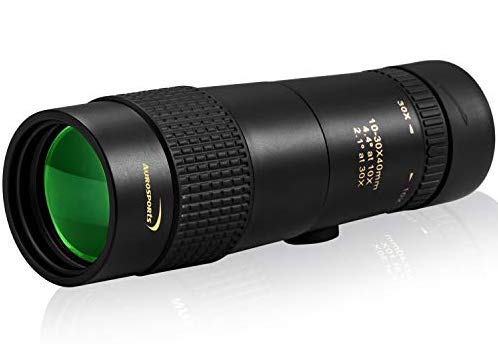
One problem with choosing a monocular is you’ll have to decide how much magnification you want, and then you’re stuck with it. But that’s not the case with the Aurosports 10-30×40 zoom monocular. This device zooms from 10x-30x magnification, allowing you to get a close-up view when the action is far away.
Despite the extra zoom capabilities, this monocular is actually priced very affordably. In fact, it’s one of the cheapest monocular telescopes on this list. At this price, it still manages a light weight of less than 6 ounces and an incredible field of view that spans 419 feet at 1,000 yards.
But there were several drawbacks to this device that we have to mention. First, it’s much larger than you might think by its light weight. It’s actually pretty bulky to accommodate the increased zoom. Worse, it doesn’t seem to live up to those magnification claims. It’s supposed to reach 30x magnification, but it never felt like we got close to that number. At any range, we had a very hard time getting it to focus properly, which are all reasons why this monocular is ranked in the bottom half of our list.
- Priced affordably
- Zooms from 10x-30x magnification
- Super-wide field of view
- Weighs less than six ounces
- Difficult to get in focus
- Doesn’t seem to live up to magnification claims
- It’s big and bulky
7. Emarth 10-30X50 Zoom Monocular

The Emarth 10-30×50 zoom monocular is another device offering zoom magnification that ranges from 10x-30x. Unfortunately, this one is even bigger and bulkier than the Aurosports zoom monocular. At just shy of a pound, it’s also heavier and even costs more as well.
This device is IPX-7 waterproof thanks to nitrogen purging. Not only is protected from water, but it’s coated in a durable rummer armor that ensures your monocular is also protected against drops, spills, scratches, and more. Plus, the armor provides grip so it’s less likely to slip from your hand.
But the real test of any monocular is its image quality, and this one doesn’t do so well in that department. The image is hazy and dull. No matter what we did, we couldn’t get it to sharpen or brighten. Consider its bulky size and mediocre optics, we wouldn’t recommend the Emarth zoom monocular.
- Zooms from 10x-30x magnification
- IPX-7 nitrogen-purged waterproof
- Durable rubber armor exterior
- It’s bulkier than other options
- Weighs more than other models
- Hazy image quality
- Related Read: Monocular vs Spotting Scope: Which Should You Choose?
8. Leica 8×20 Waterproof Monocular – Best Waterproof Monocular
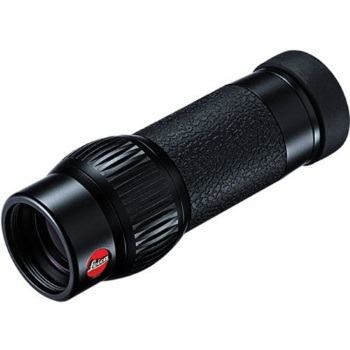
It’s always useful to have a monocular that is waterproof. Of course, that doesn’t necessarily mean that it’s going to take a swim and be okay but the Leica 8×20 should withstand most weather thrown at you. As you can probably tell, this is a very rugged, durable product and it doesn’t stop there. The lens of the monocular has a coating that is water and dirt repellant. No wonder we consider this to be one of the top picks for hunting and bird watching!
Of course, it’s not all about the durability of the product. The dimensions of the Leica 8×20 are 3.9″ x 1.5″ x 1.5″. This makes it small enough to fit in your pocket. What’s more, it weighs only 4 ounces so it’s a very portable product that won’t hinder you in any way. To top it all off, this monocular offers great optics. Even at the maximum 8x magnification, images are surprisingly clear. We really like that it’s an easy product to use which just makes it even more convenient. Granted, it’s not the cheapest monocular on the market. But overall, we think it’s well worth the price.
- Waterproof and fog proof
- Excellent optics even at greater magnifications
- Small enough to fit into your pocket
- It’s an expensive product
9. BARSKA Blackhawk Monocular
The BARSKA Blackhawk Monocular is a reasonably priced device that offers a few decent features. But overall, it’s not a tool that we were very pleased with. Let’s start with the good stuff though.
This monocular is nitrogen purged and sealed, offering excellent protection from water and dust while preventing the lens from ever fogging up. The overall design is rather compact and features a protective rubber armor with a non-slip diamond grip and finger molds for a comfortable and stable hold.
As soon as we pulled this from the box, the strong rubber smell became apparent. This may not affect every use, but if you want to use your monocular for hunting, that odor is going to be a problem. Similarly, the noisy Velcro for the wrist strap will alert any prey near you to your presence.
But the problems here go much deeper. The first Blackhawk we received was broken; the focusing knob just turned and turned. Naturally, we started to lose faith in BARKSA at this point. The second one worked, but the image quality was sub-par with too much chromatic aberration.
- Nitrogen purged and sealed
- Non-slip diamond pattern rubber exterior
- Strong rubber smell makes it useless for hunting
- The first one we received was broken
- Noisy Velcro
- Noticeable chromatic aberration
10. Gosky Titan 12×50 Monocular
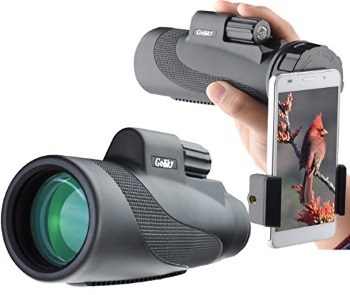
When you see the price, you’ll understand that the Gosky Titan 12×50 isn’t the best product for all sorts of outdoor activities such as hiking, hunting, and watching wildlife. It offers 12x magnification and he objective lens measures 50mm for clear and bright images. While the optics cannot be compared to more upmarket monoculars, they’re good for the money. As you may expect from a more budget monocular, it’s not as light as more expensive products. It weighs 13.9 ounces and has dimensions of 3.4″ x 7.1″ x 2.8″.
One of the most interesting features of the Gosky Titan 12×50 is the quick alignment smartphone adapter which is compatible with all of the latest smartphone models. This allows you to take photos and videos of what you’re looking at so that you can share the views with others! In general, we like the construction of this product, which feels quite durable. The rubber armor provides some shock resistance while it also happens to be waterproof and dustproof. As such, it should last a long time.
- 12x magnification is impressive for the price
- Smartphone adapter for photos and videos
- Solid build with rubber armor exterior
- Optics aren’t comparable to top quality products
- Included accessories are fairly cheap

Buyer’s Guide – Choosing the Best Monocular For You
So you’ve decided that a monocular is the right choice for you. Whether you’re buying a monocular for hikes, birdwatching, hunting, concerts, or sports games, you’ll find our buying guide very helpful. Here you can learn about the advantages of monoculars over binoculars, the most important features, and more!
Monoculars vs Binoculars
Monoculars vs binoculars is a great debate. But why should you choose a monocular over a pair of binoculars? Well, while binoculars tend to be more powerful, the monocular is much smaller and lighter. In fact, they’re so compact that you can often fit them in your coat or trouser pocket. This makes monoculars much more convenient for anyone who needs to travel light when on a long hike or hunt, for example. What’s more, they’re easy to use.
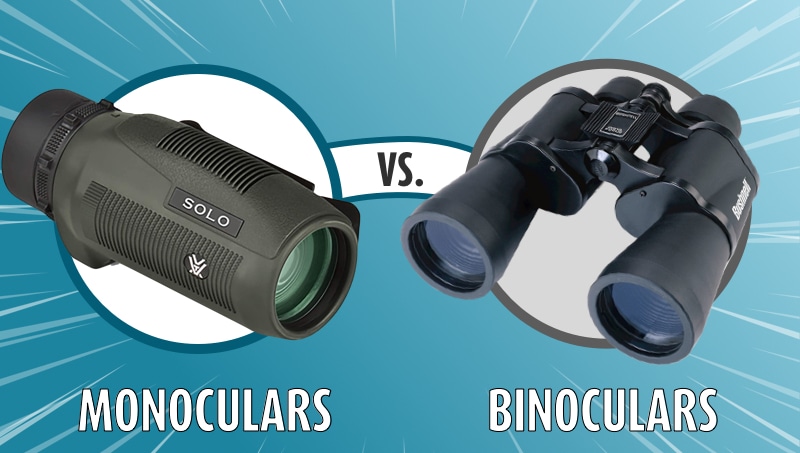
In terms of price, monoculars are fairly cheap to manufacture in comparison to binoculars so you can also get more bang for your buck.
Considerations When Picking the Right Monocular Telescope
All of these monoculars are designed to help you see far-off subjects in greater detail. They all magnify your subject so you can see it more clearly and they generally look pretty similar. But when it comes to performance, there are a few select traits that are responsible for major differences between models. Let’s take a look at those features and help you determine what you need in each category.
Size
One of the main reasons to choose a monocular over binoculars is their compact size. A monocular is essentially half a pair of binoculars. As such, they’re about half the size and weight.
That doesn’t mean all monoculars are the same size though. Differences in design can lead to drastic size discrepancies. For instance, some designs feature a focus ring that wraps around the main body, leading to a streamlined monocular. Others feature a separate focus dial on top of the main telescope, which can cause it to be considerably larger.
Weight
In general, most of these devices weigh less than a pound. Some are very close to that one-pound mark while others are well below half a pound in weight. That might not seem like a huge difference, but after holding it to your eye for several minutes, you’ll start to feel that extra weight.
Magnification
Magnification measures how much larger an object appears when viewed through your lens. If your monocular offers 10x magnification, then anything viewed through it will appear ten times larger. Another way to think of it is that the subject will appear ten times closer.
Monoculars come in a wide range of magnification levels. You can often even choose from several magnification levels on the same monocular. If you plan on viewing objects that are very far, then you’ll want more magnification.
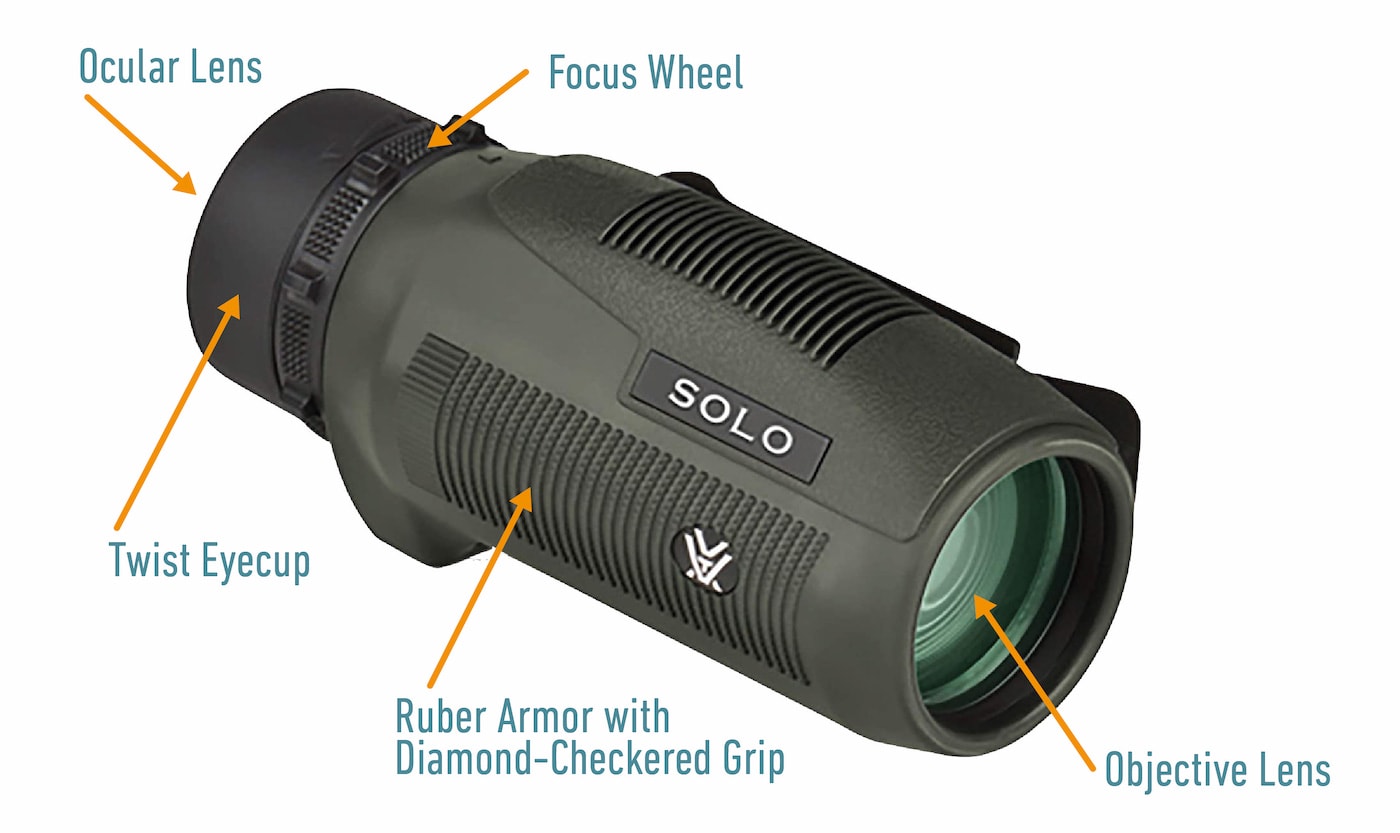
Image Quality
The entire point of a monocular is to improve your viewing ability. So, it stands to reason that image quality is one of the most important aspects to compare between monoculars.
Some things to look out for are viewing range, clarity, and brightness. Viewing range determines how far your monocular will allow you to see and can be heavily affected by magnification. Clarity refers to how sharp your image appears. You don’t want it to be clear in the middle with blurry edges. And if your image isn’t bright, then you won’t have a pleasurable viewing experience in any light conditions.
Price
Just because a monocular costs more doesn’t mean it performs better. We tested some extremely expensive monoculars that offered sub-par performance. On the other hand, we tried out some affordably priced devices that managed some impressive performance and image quality. Don’t assume that you have to spend a fortune to get a quality monocular. Sometimes, quality comes in an affordable package.
Weatherproofing
Many of the times that monoculars see use involve outdoor activities. Hunters, bird watchers, and those attending sports games all use monoculars to get a better view. But this leads to the possibility of contamination by water, dust, and more. Luckily, manufacturers have taken this into account by offering weatherproof devices.
If you know you’ll be using your monocular outside, then we recommend looking for the most reliable weatherproofing you can find. Nitrogen purged weatherproofing is an excellent choice and argon purged weatherproofing is even better.
•You might also like: How Does a Doorbell Camera Work? The Interesting Answer!

Conclusion
All of these monoculars perform the same basic function. They allow you to see far off objects in great detail. But that doesn’t mean they’re all equally good at the job they perform. Some offer an excellent viewing experience and others provide a mediocre image quality at best. After putting so many of these devices to the test for our reviews, we’ve settled on three that we feel confident recommending.
For most situations, we recommend the Wingspan Optics Explorer. This waterproof and fog-proof monocular is coated in non-slip armor and offers an incredible viewing range of 1000 yards with 12x magnification.
If you’re looking for the best bang for your buck, we suggest the ROXANT high definition grip scope. It features retractable eyecups that work with glasses, non-slip grip for comfortable holding, and a wide-view lens. Best of all, it manages all this at a very affordable price.
On the premium end of the spectrum, the Bushnell Legend Ultra HD monocular gets our vote. It’s 100% waterproof and fog-proof with superior optics that provide an incredible viewing experience. Plus, it comes with a Picatinny rail for attaching it to a firearm.
Table of Contents
- A Quick Glance at our Favorite Monoculars for 2025
- The 10 Best Monoculars
- 1. Wingspan Optics Explorer Monocular – Best Overall
- 2. Roxant Grip Scope Monoculars – Best Value
- 3. Bushnell Legend Ultra HD Monocular – Premium Choice
- 4. Vortex Optics Solo Monocular
- 5. VIVREAL Monocular Telescope
- 6. Aurosports 10-30×40 Zoom Monocular
- 7. Emarth 10-30X50 Zoom Monocular
- 8. Leica 8×20 Waterproof Monocular – Best Waterproof Monocular
- 9. BARSKA Blackhawk Monocular
- 10. Gosky Titan 12×50 Monocular
- Buyer’s Guide – Choosing the Best Monocular For You
- Considerations When Picking the Right Monocular Telescope
- Conclusion
About the Author Robert Sparks
Robert’s obsession with all things optical started early in life, when his optician father would bring home prototypes for Robert to play with. Nowadays, Robert is dedicated to helping others find the right optics for their needs. His hobbies include astronomy, astrophysics, and model building. Originally from Newark, NJ, he resides in Santa Fe, New Mexico, where the nighttime skies are filled with glittering stars.
Related Articles:
How to Clean a Refractor Telescope: Step-by-Step Guide
How to Clean a Telescope Eyepiece: Step-by-Step Guide
How to Clean a Rifle Scope: 8 Expert Tips
Monocular vs Telescope: Differences Explained (With Pictures)
What Is a Monocular Used For? 8 Common Functions
How to Clean a Telescope Mirror: 8 Expert Tips
Brightfield vs Phase Contrast Microscopy: The Differences Explained
SkyCamHD Drone Review: Pros, Cons, FAQ, & Verdict




